AI Generated Art
Just another tool or a creator nightmare?
I’ve been curiously watching the news from the sidelines as AI-Generated Art has been recently making quite a splash. So, what’s all the fuss about?
First - I do not claim expertise in this area. I am not a digital artist, though I dabble with digital tools. I do, however, care deeply about artists' rights while also trying to keep an open mind about new tools as they evolve.
Secondly - for those of you, like me, who may be catching up on the latest information about AI-Generated Art as it continues to make headlines - I will start with a short description and then sprinkle in several articles to help understand the current zeitgeist (with a summary of the included articles at the end).
What is AI-Generated Art?
As explained in “The Rise of AI Art: What is it and is it really art?” (interestingengineering.com): Basically, AI art is generated using machine learning algorithms and deep neural networks. “Large sets of already-made art are used to teach these algorithms how to find patterns and styles that can be used to make new art.”
So why all the fuss?
To try to understand the AI-Art generation process a little better, I decided to try out a couple of tools currently available. First, I used the app Artist.AI to generate a few images using text prompts with (and without) reference photos.
The art generated below uses images of one of my floral paintings, a photo of my cat, and my “27 Birds” painting for their reference points.
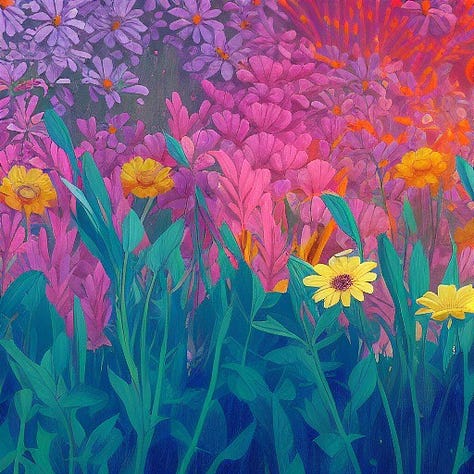
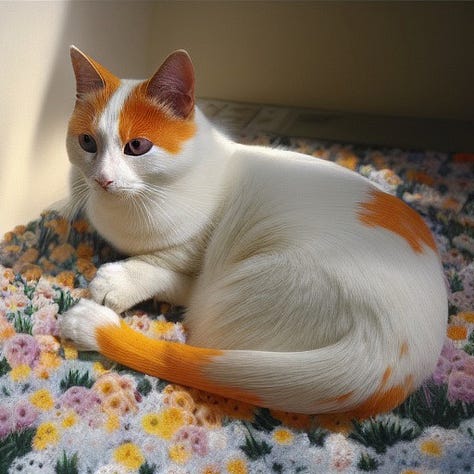
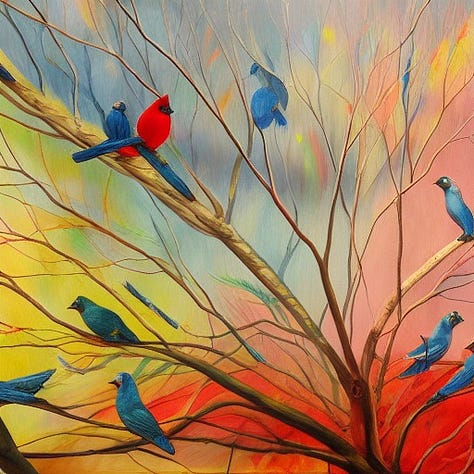
I admit being relieved that I don’t have a “known artist” presence here. Trying to generate images “in my style” produced nothing like my work unless I attached an actual image of my work to the prompt. (Unlike the artist, Kelly McKernan, who found their work being used by Deviant Art’s new AI generator tool to create new images in their style). You can listen to the Podcast Episode, “Art vs. AI” on NPR’s The Indicator from Planet Money as they interview Kelly about this issue.
In fact, I was amused by these images which DALL-E (one of the forefront AI-Image generation tools by Open.AI) produced “in the style of Jennifer Lommers”.
At least it seemed to know my hair is brown?
What I did find interesting, however, was how much it felt like I was the one creating the art as I continued to play with text prompts to tease out an image from the AI that I found interesting.
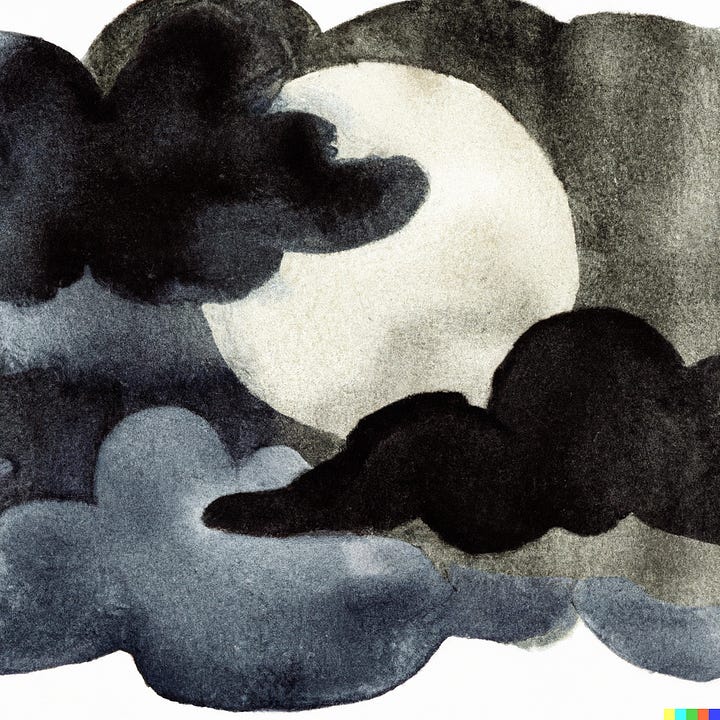
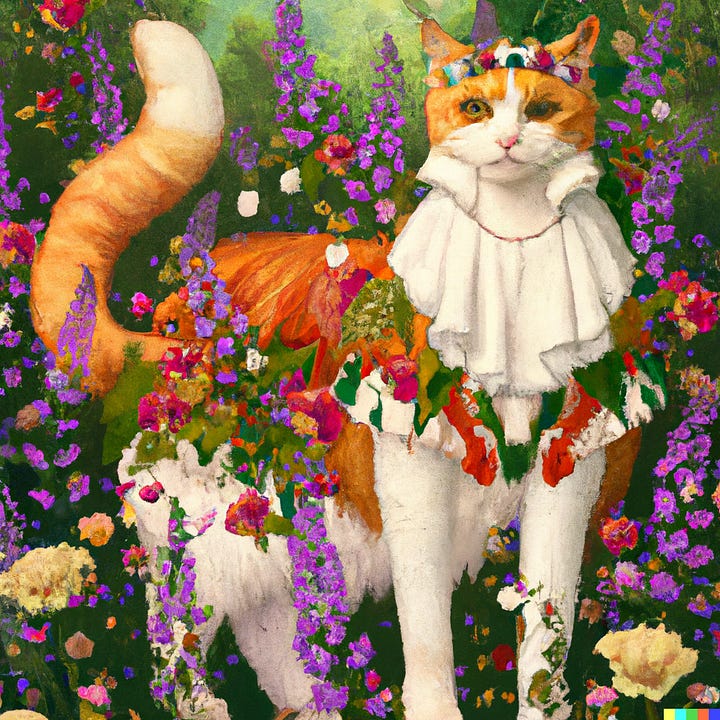
From creating simple background images (using the text prompt of “watercolor background of clouds with moon at night”) to elaborate pet portraits (using the text prompt of “digital art full body illustration of orange and white princess cat surrounded by colorful wildflowers in the style of Botticelli”). With each edit of text prompts, I received a slightly (and sometimes drastically) different interpretation. It was incredibly fun and very addictive. I started to understand the concept of AI generation as a tool, which I first encountered at an artist talk by Hito Steyerl. She shared her process of using AI with her film production. As I understood it - by using predictive technology, she would have the AI create footage based on her existing film and the text she provided. The process sounded tedious and time-consuming, as each iteration was processed to create the next frame of the film by predicting the movement from the previous frame. She also humorously noted how much difficulty the AI had in predicting human movement (specifically dance). She showcased the possibilities and limitations of the technology. She also (hopefully amusingly) noted - does she think AI will take over the world? No. Does she think it will replace artists? Also no. She seemed to brush off that notion, likening it to the rise and fall of NFTs, and predicted its novelty would wear out soon enough. And she should know - as one of the most preeminent “moving image artists” using AI technology today. In her work, she offers… “critical reflections on the complexities of the digital world, global capitalism, and the implications of artificial intelligence (AI) for society…” - all of which are explored in her current exhibition, This is the Future, at the Portland Art Museum.

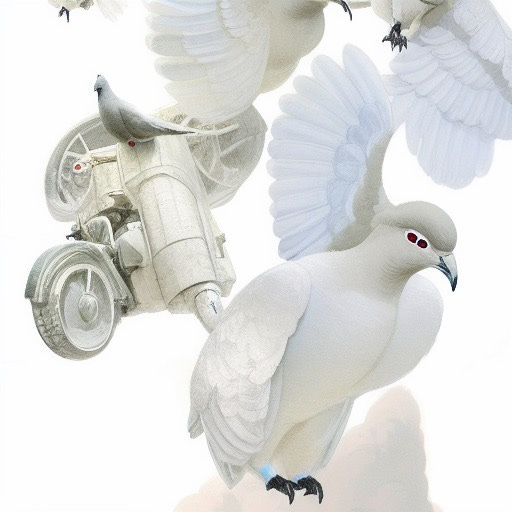
As I continued playing with the AI generation tools, I started requesting reinterpretations of my more dimensional art using text prompts paired with different styles choices (such as “Ghibli”, “Steampunk”, “Magical”, “Van Gogh” etc.) which allowed me to turn my paper-embroidery collage art into a “House of Joy” digital image, and my white paper mobile flower forms into “steampunk flock of doves with clouds". I began to understand a little bit more about what Steyerl was explaining. With a few changes to the text or a different filter, I could see before-unimagined possibilities within my own artistic creations. And the variables seemed limitless.
I could see the intrigue in using AI to generate art.
There are several AI generators in the field, including these 5 from zdnet.com: DALL-E 2 by OpenAI, Dream by WOMBO, Craiyon, Midjourney, and MyHeritage’s AI Time Machine.
So how do they work?
From “What is DALL-E and How Does it Create Images from Text” (makeuseof.com)
DALL-E is an easily accessible AI tool that you can use to make art or generate images, none of which have ever existed before. It makes use of incredible advances in machine learning, including GPT-3 and diffusion models. DALL-E's knowledge of the human world, including the history of art, comes from millions of images that were likely gathered from the internet.
Since of course, I, like many artists, am always concerned about copyright infringement, let me repeat.. these images are coming “…from millions of images that were likely gathered from the internet.”
And here is where I see the line between artist and AI blurs, and where issues arise. It’s not “What IS AI?” so much as who is using it, who is profiting from it, and how it is being used. Is it a tool? Is it art? There are many people much more knowledgeable on this topic than I am exploring and writing about the world of AI-generated art. There are lawsuits, fears of job loss, and cheers for a new tool making art more accessible (everyone can feel creative typing text to create images), less expensive (as a tool, AI makes certain steps of illustration and animation easier and less time-consuming), but as some note, it can also be, at times, creepy and soulless (as evidenced by this AI-generated art shared on CreativeBloq.com.)
And, as noted in the article, “Five artists who show art’s important relationship to AI”
One of the most interesting aspects with AI art is that it creates a situation in which we can begin to reconsider our approach to non-human entities – Ben Vickers
Vickers continued by explaining, “You have this mainstream narrative of AI being a kind of master-slave dialectic, where it's either this omnipresent god or is somehow in service to you. But a lot of artists are working in this moment to rethink and reframe that narrative, to think about a different relationship to non-human entities. I don't necessarily see this as binary in terms of good or bad, but it does quite unsettle things currently in play. One of the most interesting aspects with AI art is that it creates a situation in which we can begin to reconsider our approach to non-human entities that we're interacting with, which, forces us to rethink our relationship to other non-human entities, such as the entire animal kingdom, other forms of consciousness.” (from DazedDigital.com)
The 5 artists of note mentioned in the article?
Ian Cheng, Lynn Hershman, Jenna Sutela, Hito Steyerl, James Bridle
In fact, the deeper you dig into the topic of AI art, the further it reaches. It’s already making waves in the literary world and is predicted to affect all aspects of the arts. It’s a bit of the wild west out there right now.
What else is being talked about? More articles of note…
Artists, like Kelly McKernan, are fighting to protect their image rights via a class action lawsuit (Anderson v. Stability Art LTD) - reporting available from Reuters article, Lawsuits accuse AI content creators of misusing copyrighted work by Blake Brittain.
In related news, there are AI “Opt Out” Artist Options starting to show up - such as found in this MakeUseOf article “How to Know if Your Image Trained an AI Model” by Garling Wu.
And most recently, this PBS NewsHour Episode - Artificial Intelligence raises the question about the future of art.
And finally, this article: Netflix stirs fears about using AI-assisted background art in short anime film (arstechnica.com).
I’m honestly not sure how it’s all going to shake out, but as Hito Steyerl noted in the Artist talk I attended: The real issue is misinformation bots with artificial stupidity being one of the greatest threats of our time.
So, maybe the issue is not with AI, but with whether or not we believe it.
In the meantime, I’ll be watching with interest, doing what I can to protect my own images, and maybe even generating something fun (or at least entertaining) along the way.
(I’m loving this interpretation of my new sweater!)
Until next week,
Jennifer
Sources:
“The Rise of AI Art: What is it and is it really art?” (interestingengineering.com)
“Art vs. AI” on NPR’s The Indicator from Planet Money
“The Best AI Art Generators” (zdnet.com)
“What is DALL-E and How Does it Create Images from Text” (makeuseof.com)
“Five artists who show art’s important relationship to AI” (dazeddigital.com)
“Lawsuits accuse AI content creators of misusing copyrighted work by Blake Brittain” (Reuters.com)
“How to Know if Your Image Trained an AI Model” (makeuseof.com)
“Artificial Intelligence raises the question about the future of art” (wqed.org)
“Netflix stirs fears about using AI-assisted background art in short anime film” (arstechnica.com)



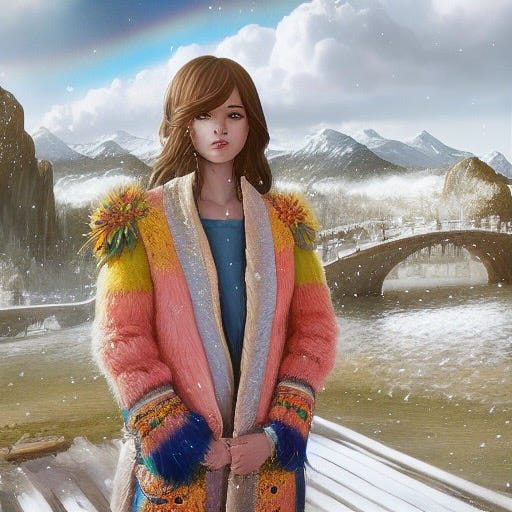
I appreciate your sharing what you have explored and discovered about AI. It's not something I would have thought about before.